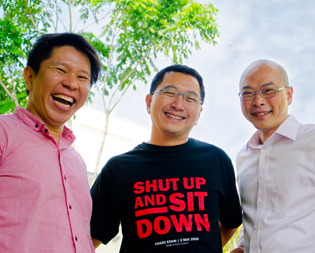Why Singapore’s English Teachers Should Embrace Singlish, Not Fight It
Is it time for Singaporean educators to embrace Singlish as a legitimate learning tool? What the Research […]
Read More
Real-world situations can be challenging and complex, often requiring solutions that cut across various domains of knowledge, thought and practice. NIE educators have a creative way of tackling this.
Education today needs to prepare our students for an increasingly complex and dynamic world. Junior College (JC) education, in particular, aims to develop future leaders who are equipped to deal intelligently and creatively with real-world issues.
Three NIE colleagues put their heads together to find a way to help new JC teachers. The result was “Knowledge Skills” – an interdisciplinary course designed to develop the attitudes, knowledge, skills and values expected of JC teachers.

As an interdisciplinary course, it is only fitting that the course co-ordinators are from three different academic groups in NIE.
“JC students are supposed to be on a leadership track,” explains Benjamin Wong, one of the masterminds behind this course. “We want to prepare them to take leadership roles in a 21st century world.”
This involves dealing with what he calls “wicked problems” – real-world problems that are not so easily defined, and solutions which could cause other problems.
Dennis Yeo, one of the trio, believes this is vital because JC is the “end of the assembly line” in terms of achieving the desired outcomes of education. JC teachers have one last shot at imparting as much knowledge and skills as possible to make sure their students are prepared for the real world.
“Students must be ready to go out into the market, one that is very volatile and changing. They need to deal with that kind of flexibility,” says Dennis.
So how do you inject creativity into the JC system – one that is intensely exam-oriented and where lesson time is a limited commodity?
Their answer is to teach “process skills” which can be used across subjects. Skills like multidimensional thinking and critical literacy. To do so, they have chosen to adopt an interdisciplinary approach.
The reasons for this are simple. For one, classes like General Paper aren’t subject-specific and are more focused on skills like critical literacy. “We’re getting students from all sorts of subject areas, that’s why we’re emphasizing skills,” says Dennis.
Also, in the real world, disciplines such as Physics, Economics and Literature do not exist in silos: they are interrelated. “Having knowledge is one thing, but how do you apply it? How do you contextualize knowledge and put it to meaningful use?” asks John Yeo, the third part in this dynamic combination.
The challenge, says John, is to integrate all these process skills together in practice. “The module doesn’t just teach skills alone but the understanding is critical, and then the skill sets can come in real and applied ways for teaching.”
“It isn’t a lesson on creativity or critical literacy skills but part of the process of learning and the process of gathering knowledge,” adds Dennis. “These skills are applicable in whatever real situation. It’s not something that’s outside of what teachers are teaching; it’s something they can imbue within the lesson plan itself.”
Trusting that teachers already have the required content knowledge, this course gets them to go deeper.
“We encourage students to start asking different questions, to ask deeper questions of the discipline,” notes John. “If we keep asking the same questions from the textbook, we won’t get new answers.”
 He continues: “The idea is to take that discipline knowledge and push it into more applied ways, and with greater novelty. Novelty can reside within the subject matter, but sometimes we need to think deeper, and to look across the subjects.”
He continues: “The idea is to take that discipline knowledge and push it into more applied ways, and with greater novelty. Novelty can reside within the subject matter, but sometimes we need to think deeper, and to look across the subjects.”
This course goes further by injecting a values component into the disciplines. “Once you understand the history of the disciplines, and the ones who came up with the theories, you humanize the discipline,” Benjamin explains.
We start to realize that disciplinary boundaries are artificial, and there is much we can gain from drawing on both the arts and the sciences. “That enriches the understanding of the discipline and the ethical elements come in very strongly.”
Interdisciplinary thinking changes the way you think about the disciplines.
Having a broad base of knowledge of various disciplines will allow teachers to incorporate a range of skills within the curriculum. “It’s a change in the paradigm of how they plan their lessons,” says Dennis.
“The course helps them think about how to go about changing the format and structure of the classroom, how they go about questioning and the types of questions that they ask, and how they are going to make that kind of thinking visible and tangible for the students,” he explains.
On the practical side, this takes a bit of courage, especially with in the short two-year timeframe of the JC system. “Thinking out of the box is a very apt way to talk about creativity, but thinking out of the box requires rule breaking, and that requires courage,” says Dennis.
But that leap of faith, once taken, opens the door to more creative teaching and critical learning. As Benjamin explains: “As they engage in this interdisciplinary process, they build confidence in relating to others and to overcome fears, especially the fear of new things and the fear of failure – if you’re afraid to fail, you won’t try new things. Once you overcome this fear, it opens the door to creativity.”
Useful Resources
Holt, J. (1982). How children fail (2nd ed.). New York: Merloyd Lawrence, Delta/Seymour Lawrence.
Holt, J. (1983). How children learn (2nd ed.). New York: Delacorte Press.